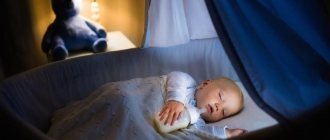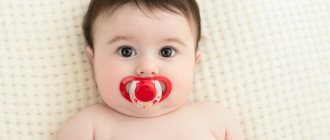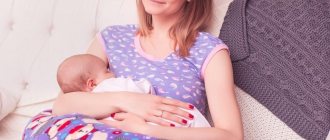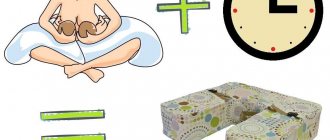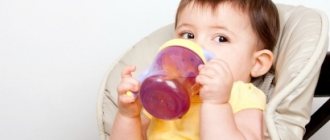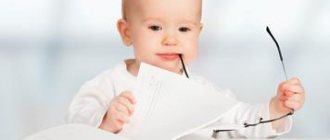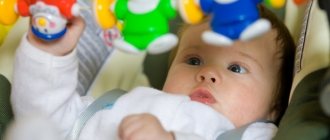Pillows for newborns appeared on the market not so long ago, but are rapidly gaining popularity. This is explained by the fact that every parent wants only the best for their child and strives to provide him with things that are good for health. But many mothers have no idea why such pillows are needed, what their types are and their purpose. Therefore, it is so important to find out the characteristics of the product, beneficial properties and possible contraindications before making a purchase.
Why is it necessary?
Parents often ask pediatricians and orthopedists how to make their baby’s sleep better and more peaceful. At the same time, an orthopedic pillow for newborns is offered as an alternative, about which I would like to hear feedback. Such anxiety is justified, because at first the newborn spends a lot of time sleeping.
Here it should be understood that experts are divided in their opinions. However, most modern doctors claim that high-quality pillows for newborns can help solve many problems. Thus, an orthopedic lining is recommended for torticollis, for the harmonious development of the spine and obtaining the correct shape of the skull, which is compressed during passage through the birth canal.
It is important that, regardless of the purpose of the pillow, its type and properties, all products for infants should be made only from safe and hypoallergenic materials.
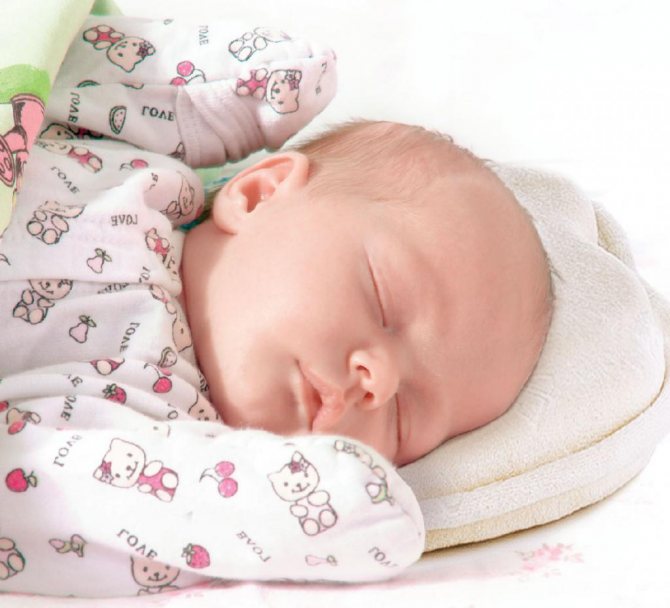
The need for an anatomical pillow for pathologies
Sometimes an orthopedic pillow for children is needed due to the presence of congenital pathologies. The pediatrician must first examine the child and understand at what age this particular child should be put to sleep on an anatomical pillow.

- With torticollis, the muscles of the cervical spine are poorly developed, which leads to the fact that it is constantly tilted to one side. If treatment is not started in time, the baby will develop scoliosis in the future. For torticollis, the pediatrician recommends that the baby sleep on a special pillow with an indentation (turned to the sore side).
- Hypotonicity and hypertonicity. In this case, massage and physiotherapy are often prescribed. An orthopedic pillow also helps to correct the condition of the muscles. Any orthopedic doctor will advise you to buy it.
- In case of birth injuries in a baby, the pain can be eased in this way. Surprisingly, the anatomically correct shape has been proven to calm nerve endings.
- When rickets has been diagnosed at an early stage, a special anatomical pillow can be used to avoid deformation of the cervical spine.
In any case, before using an orthopedic product, you must consult with your doctor and find out at what age your child can sleep on an anatomical pillow.
- Supports the cervical spine, normalizes muscle tone.
- Helps to avoid flattening in the occipital region, from birth it forms the correct shape of the baby’s skull.
- Allows you to avoid putting on caps and regulates the temperature that is comfortable for your child.
Special cases when a pillow is needed
A pillow is needed if the child:
- asthma, pathologies of the respiratory tract or nasal septum;
- torticollis, underdevelopment of the muscles of the chest, back and shoulder region;
- birth injuries of the neck and spine;
- rickets, bone fragility: bones weakened by the disease experience a large load that must be removed and properly distributed;
- deformation of the skull during childbirth: since the bones of the baby’s skull are not fully connected, during childbirth the head often becomes asymmetrical. A properly selected pillow will help correct the situation by applying gentle pressure to the desired part of the head;
- increased intracranial pressure: the correct angle of head elevation will help relieve pain, normalize sleep and restore blood flow;
- frequent regurgitation: in such a situation, the child is in danger of choking in his sleep, and the doctor prescribes a trapezoidal pad so that the head and upper part of his body are always elevated.
At what age do you need a pillow?
For newborns, a folded diaper is placed under the head. This is the maximum permitted lift. From one to two years, the diaper is folded in four; from two to three years old, pediatricians and orthopedists allow the baby’s head to be raised to a height of no more than 4 cm. From three to 7 years old - a maximum of 8 cm, and only when the child reaches school age (if desired) is transfer possible on an “adult” pillow.
We recommend reading: How to cleanse the blood in the body: quick cleansing at home
The correct shape and filling are important so as not to interfere with blood flow in the neck and not lead to pinched muscles. A well-chosen product lifts the head, neck and chest - this way the spine does not bend. Only a doctor will tell you exactly at what age an orthopedic pillow for newborns is needed for a particular child. If a healthy baby constantly slides onto a flat mattress in his sleep, he is unlikely to need to put something under his head. During sleep, the body itself assumes the most comfortable position.
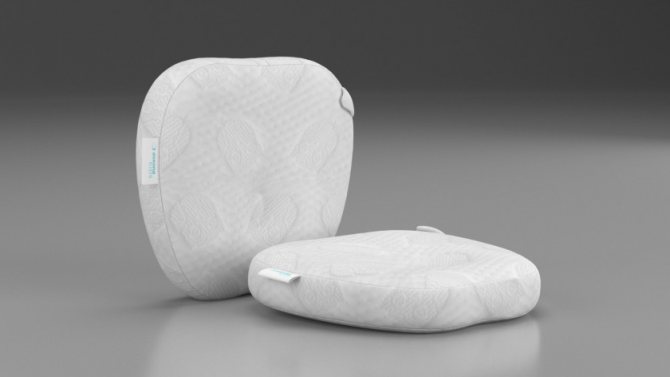
How to choose a pillow
With a huge assortment in stores, it is important to approach the choice responsibly and adequately.
- Dimensions - correct length, height and width. Choose a small width (30-40 cm) so that the child can sleep next to him when he is uncomfortable. The optimal length is equal to the width of the crib, so the product does not move if the baby turns around in his sleep;
- filler and surface - give preference to hypoallergenic materials: polyurethane foam, latex, comfort and lyocell (eucalyptus fiber), artificial down. Avoid organic fillers such as wool, feathers and cotton, as these provide breeding grounds for parasites. Porous sponge materials reduce the risk of sudden infant death syndrome because they do not interfere with breathing, even if you bury your face in them. The top of a good pillow for a child is covered with natural fabric without unnecessary elements, buttons and fasteners - they rub and scratch the skin;
- shape - orthopedic, anatomical (“butterfly”), classic, headrest, trapezoid, open ring (suitable for feeding, but not for sleeping) and many others. It is not difficult to choose the right one for a particular child, but only after consulting a specialist;
- characteristics of the child's body. For torticollis, one type of pillow is recommended; for frequent regurgitation or increased intracranial pressure, a completely different one is recommended;
- age. The inclined one, which is placed under the mattress and only slightly lifts the child, is used up to three years, and the limiter (a roller that fixes it on the side) is used up to 6 months. Anatomical, if prescribed, is used from three weeks to two years.
The most common trapezoidal sleeping pillow for newborns up to one year is a long triangle, raised by 1.5-2 cm with a smooth angle of inclination of 25-30°. It is prescribed for frequent regurgitation.
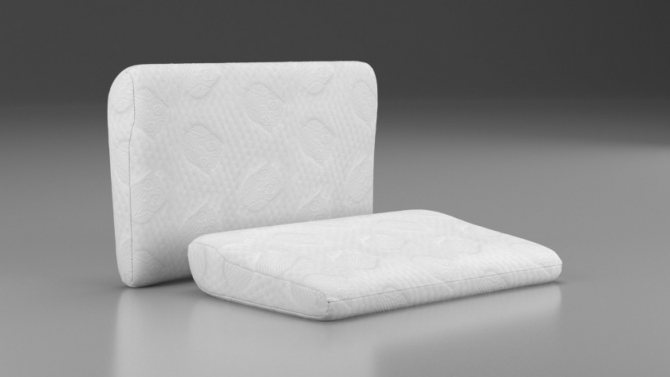
Does your baby need a pillow?
Modern pediatricians recommend not placing a pillow under the head of a healthy child during infancy. If a newborn sleeps on a pillow, the attribute familiar to adults leads to:
- to curvature of the neck, shoulder girdle and back. A newborn's bones are soft and flexible. If he remains in an unnatural position for a long time, they take on the wrong shape. This also leads to pinched muscles, blood vessels, oxygen starvation of the brain and general developmental problems;
- sudden infant death syndrome. One of the reasons is that the child suffocates with his nose buried in the bed linen. At an early age, the brain does not give commands to change body position, even if it is dangerous or uncomfortable. A pillow for an infant under two years of age is not only not needed, but is contraindicated without a doctor’s prescription;
- allergic reactions. It is unknown how the body will react to the filler, especially natural ones. In addition, a seemingly harmless accessory collects dust, particles of hair and sweat, and microorganisms multiply in it, which the child subsequently breathes in his sleep;
- entry of vomit into the respiratory tract. Babies often vomit food not immediately or several times. At an age when it is impossible or difficult to turn your head on your own, an object placed under it creates additional interference.
In the third year of life, the child’s muscles and bones have become stronger, he easily changes his body position in his sleep if it becomes stuffy or uncomfortable. Only then should parents consult about changes to the crib. If there is no such desire, the absence of a pad under the head will not cause any harm.
However, there are situations when a baby needs a special product (orthopedic pillow, not much like the one we are used to) for medical reasons from almost two weeks. It can only be prescribed by a doctor after an appropriate examination.
A pillow is needed if the child:
A pillow is an essential attribute of a comfortable sleep for every person. But whether a pillow is necessary for a newborn baby is a question whose answer is not so clear-cut. Most pediatricians and orthopedists agree that a healthy newborn baby does not need this product.
Pillow characteristics
Experts have developed a specially shaped pillow for babies to sleep on. It meets all orthopedic requirements and fully adapts to the structural features of the body of a newborn child. After all, it is known that at this age children have a disproportionately large head and a small shoulder girdle.
An orthopedic pillow for newborns is designed in such a way that the child’s cervical spine is in the required position and, accordingly, develops correctly. The product relieves stress on the spine and provides good support for a large head.
There are also no problems during operation. Pillows for newborns are made from materials that can be easily washed and dried quickly. At the same time, the item completely retains its properties, shape and size. In addition, the product has excellent breathability and thermal conductivity.
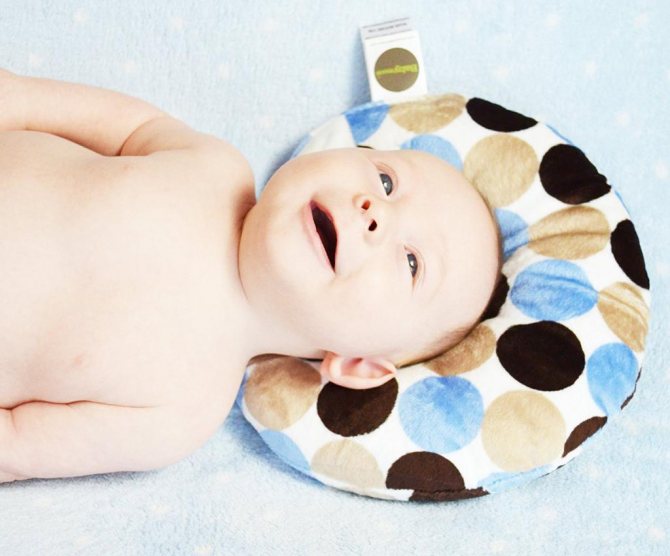
At what age does a child need a pillow?
When asked when you can put your baby on a pillow and whether a newborn needs a pillow at all, most pediatricians answer unanimously: it is not necessary. In a child under two years of age, the proportions of the head and body differ significantly from those in adults.
The distance from the head to the surface on which the child sleeps is much smaller, because his head is larger relative to his shoulders. Therefore, it is comfortable for him to sleep without using a pillow, regardless of what position the baby occupies in his sleep.
And after two years, to ensure a comfortable sleep, the baby needs a pillow no more than two centimeters thick, that is, just enough to level the distance between the ear and shoulder.
But there are times when a baby simply needs a pillow from birth. So, it becomes a necessity when the child has any developmental abnormalities, curvature of the neck or spine, hypotonicity or hypertonicity of the muscles.
Important! Under no circumstances should you select an orthopedic pillow on your own, but only on the strict instructions of an orthopedic doctor, after a correct diagnosis.
Need to purchase
Not all newborns need to purchase a pillow. Only after passing the examination and receiving recommendations can you begin to make a choice. Any qualified doctor will immediately identify indications for its use. Undoubtedly, you should use a pillow for a newborn in a crib if:
- The baby showed the first signs of rickets. In this case, support for the spine is simply necessary. Also, using a pillow helps reduce the risk of neck deformation.
- The newborn was diagnosed with torticollis. In this case, any specialist will recommend the type of pillow that needs to be purchased. Moreover, the product is used in the treatment of the disease and for its prevention.
- Increased or decreased muscle tone is observed. Pillows for newborns will help relieve stress.
- It is necessary to adjust the baby's sleep if he wakes up too often.
All products are divided into types. There are head and positional pillows. When purchasing, this fact should be taken into account.
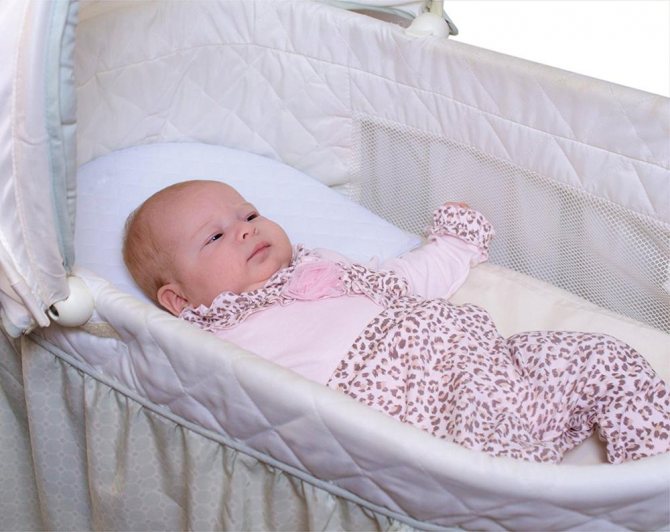
Read more about the need for pillows for babies
The range of goods in children's stores is huge. Among other things, pillows are also available. Many manufacturers and sellers claim the benefits of certain models for newborns. In this matter you should be very careful. The children's products industry is a profitable business. The task of the interested party is to sell as many products as possible to loving and caring parents. Don't rush into purchasing!
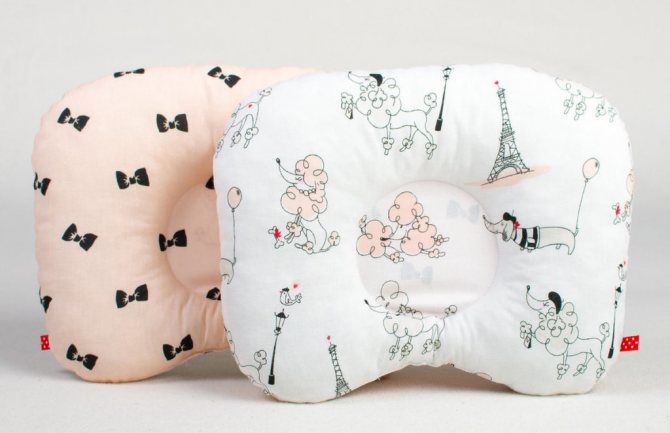
Important! What is important to understand? The anatomical structure of the body of a newborn is very different from the structure of the body of an adult.
Why is it uncomfortable for adults to sleep without a pillow? The fact is that the distance from the edge of the shoulder to the ear is quite significant. Therefore, when a person lies on his side, the head “falls” down. In order to maintain a horizontal position of the spine (which is essentially what is called comfort), we use a pillow of the required height.
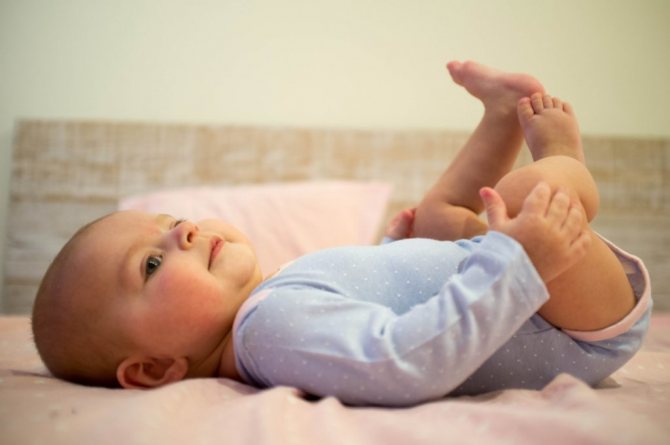
In the case of newborn babies, things are somewhat different. Even with the naked eye you can see that the proportions of the head in relation to the body in infants are not the same as in adults (the head is much larger in relation to the body). The width of the shoulders is at the same level as the size of the head. This is why it is convenient for a baby to lie on a flat surface without a pillow, no matter how good it is. Regular use of a classic head pillow can even harm a newborn.
Butterfly pillow
The product got its name because of its appearance, because it resembles an insect with widely spaced wings. A butterfly pillow for newborns is based on a ring-shaped cushion with a depression in the middle. This design is indicated for use almost from birth. As soon as the baby is one month old, it can be placed in a crib so that it is possible to properly fix the baby’s head while sleeping. A butterfly pillow for newborns is designed to relieve the baby from the problem of torticollis and other difficulties associated with passing through the birth canal.
The product helps the skull to form correctly, even if signs of rickets appear. When sleeping on such a pillow, children are in the correct position, therefore, as reviews indicate, they sleep more soundly. Experts also note that such a thing, if used from early childhood, can affect psychomotor development and a balanced psychological state.

The filling of a pillow can be completely different. Synthetic padding polyester, holofiber, and buckwheat are considered the best. There are options with feather or cotton wool, but these are not recommended for use in a newborn's crib. Feathers can cause severe allergies, and cotton wool does not hold its shape well and does not give a feeling of elasticity.
Freyka pillow for newborns
Unfortunately, there are cases when children are born with certain problems. Orthopedists often diagnose newborns with hip dysplasia. For treatment, you must follow the doctor's recommendations and use special means to fix problem areas.
The Freika pillow for newborns is a special bandage that fixes the joints in the correct position. It is threaded between the child's legs and secured with straps. Main purpose of the product:
- treatment of dysplasia;
- correction of dislocation and subluxation.
The pillow is made from durable but flexible polyurethane. For comfort, an upper cover is used, usually made of cotton fabric. Of course, the product is intended for medical purposes only and is prescribed based on the diagnosis. The pillow does not cause pain to the baby, but at first the baby may feel discomfort, cry, and have difficulty sleeping.
Memory foam pillows
Material that can remember and adapt to individual body shapes is becoming increasingly popular. At the same time, it redistributes pressure evenly and retains heat well. Parents who need a pillow for a newborn in a crib often opt for this material. Memory foam pillows have earned only positive reviews. Most mothers claim that the product precisely adapts to the contours of the child’s body and contributes to the correct redistribution of its weight.
It is recommended to be used as a prophylaxis for spinal curvature, for the treatment of vertebrobasilar insufficiency, with increased muscle tone, torticollis and increased fatigue. Often, if there is sleep disturbance, a newborn pillow is recommended. Photos of serenely sleeping children in this case are not just a publicity stunt. The product actually, judging by the reviews, promotes restful and sound sleep.
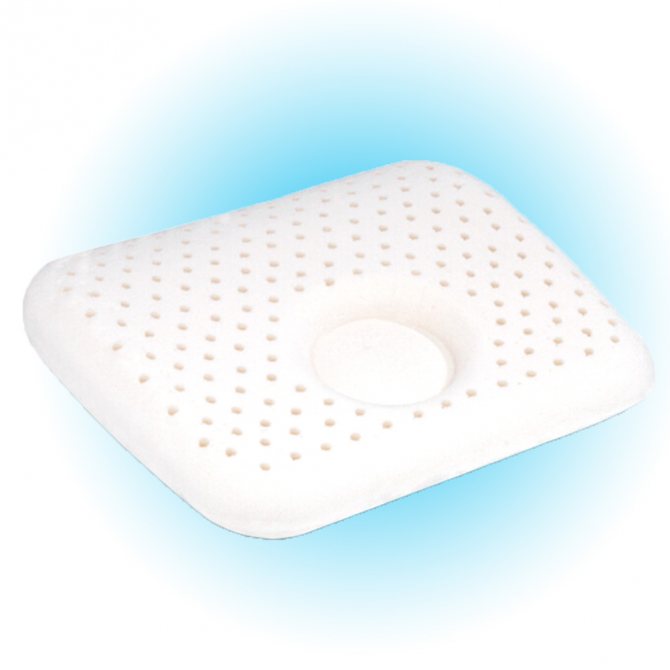
Why does a baby need this?
The use of a regular pillow for a newborn baby is strictly prohibited by pediatricians. This can negatively affect his spine and neck.
Reasons why your baby should not sleep on a regular pillow:
- If the baby turns over on his stomach, he may press his nose into the pillow, which can cause suffocation.
- When a child's head is constantly elevated, this provokes the development of scoliosis.
- Filling is down or feathers. They can cause an allergic reaction in children.
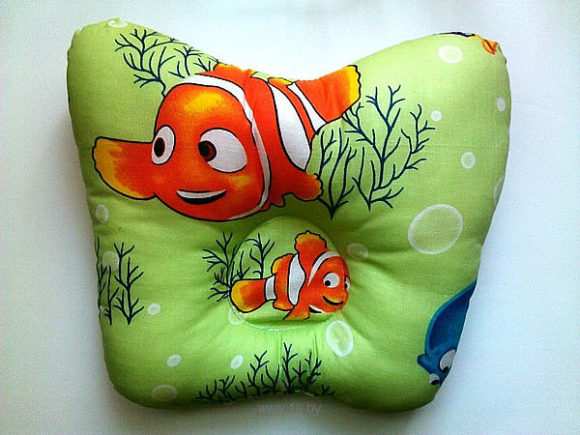
An orthopedic pillow is a completely different matter. It adapts to the physiological characteristics of the child and has a positive effect on his health.
- Supports the cervical spine, normalizes muscle tone.
- Helps to avoid flattening in the occipital region, from birth it forms the correct shape of the baby’s skull.
- Allows you to avoid putting on caps and regulates the temperature that is comfortable for your child.
At what age can a baby sleep on such a pillow? This question interests all young parents. Manufacturers are now producing options for pillows that can be used to place a child from the first days of life . Of course, it would be advisable to first consult with a pediatrician. He will tell you what kind of pillow the baby needs.
Where to buy?
It is better to purchase any children's products in specially designated stores. In this case, it is necessary to pay attention to points that specialize in the sale of children's orthopedic products and sleep products.
The range of pillows is now very large. Any parent will be able to choose a product based on the doctor’s recommendations, personal preferences and financial capabilities. If we consider the middle price segment, then the final cost is not too high, and the pillow will always come in handy in the process of caring for the baby. The price depends on the filling, external upholstery and manufacturer. In any case, by purchasing an orthopedic pillow, you don’t have to worry about your baby’s healthy sleep.
Skillful hands
Many needlewomen, when they see store-bought goods, realize that they are capable of creating something similar themselves. A pillow for a newborn is sewn with your own hands quickly and does not cause difficulties for craftswomen. But before you begin, you need to decide on the materials.
For the pillowcase it is recommended to use:
- calico;
- linen;
- satin;
- flannel;
- chintz.
The filler can also be different. If previously a pillow for a newborn was made with your own hands using down and feathers, now they are not recommended. Is the material too allergenic? and it cannot be washed quickly.
The best filler to use is:
- holofiber;
- polyurethane;
- padding polyester;
- latex.
If padding polyester is used, it is recommended to pre-quilt it.
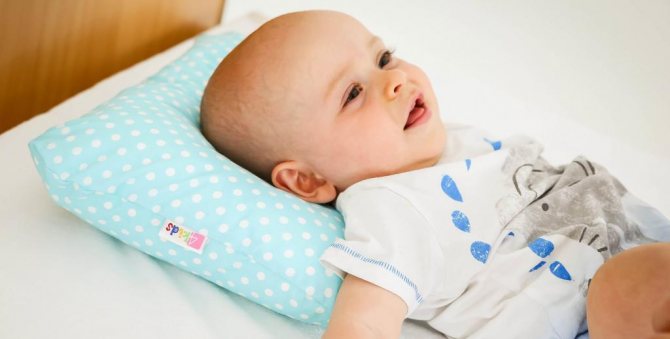
Pillow fillers for newborns
As we said earlier, the materials on children's pillows should be of high quality and natural. The same goes for fillers. Let's talk about the most common fillings for children's pillows.
Pillows for newborns with bamboo fiber
Bamboo fiber is considered the best. It is completely natural, environmentally friendly, and permeates moisture well. Bamboo pillows are breathable and your head does not sweat, which is a definite plus. In addition, this fiber has antibacterial and anti-allergenic properties, so they have virtually no contraindications for use. The only downside is the high cost of such products.
bamboo fiber pillow
Pillows for newborns with sheep wool
Pillows with sheep's wool are well suited for the winter period. Their shape remains the same for a long time, they perfectly allow air and moisture to pass through. Wool has a very beneficial effect on children's bodies. You should wash this pillow carefully, as the wool can roll into unpleasant clumps. It's best to do this manually. And so, unlike bamboo fiber, this option is contraindicated for children with a tendency to allergies.
sheep wool pillow
Pillows for newborns with buckwheat husk, coconut, herbal fibers
Buckwheat husks, coconut and herbal fibers are gaining popularity as fillings for newborn pillows. These materials are environmentally friendly and cannot harm the baby’s health, however, sleeping on them is extremely uncomfortable. Such a filler will be quite harsh for the delicate skin of a baby, so it is better to save such a pillow for another person. In addition, these materials can rustle when the baby moves during sleep.
pillow with buckwheat husk
Pillows for newborns with down and feathers
Crib pillows for newborns are often made from down and feathers. However, few mothers know that these materials are completely unsuitable for the baby. Not only do they quickly lose shape, but they can also lead to back problems. In terms of environmental friendliness, this is a controversial point. With prolonged use of such a pillow, mites and various types of bacteria may appear, leading to diseases. Excessive dust often accumulates in such a filler, which can pose a risk of asthma and skin diseases for a small child.
down pillow
Pillows for newborns with padding polyester
Synthetic winterizer is a very popular material as a filler for a baby's crib pillow. It is non-allergenic, pillows with padding polyester are easy to wash, do not lose their shape, are quite elastic, and also provide good support for the baby’s neck and shoulders. The disadvantage of such pillows is the high retail price.
pillow with synthetic padding
Other fillings for children's pillows that are gaining popularity are holofiber and comforter. These are synthetic materials and are very comfortable and warm to sleep on. Thanks to special antibacterial treatment, mites and bacteria cannot appear in such fillers.
pillow with holofiber
In conclusion, we would like to say that choosing a pillow is not a difficult task if you know a few secrets. To begin with, you should decide on the filler, consult with your doctor about the need to use a pillow, and decide on the price. The cheapest options should be discarded, since their quality leaves much to be desired. It is best to choose pillows made of synthetic materials.
Many pediatricians agree that until the age of 3, a baby does not need a pillow at all. All that remains is to advise parents to decide for themselves how necessary it is if the child is healthy.
How to sew?
To sew pillows for a newborn crib with your own hands, you need to have basic cutting and sewing skills. To get started, you need to prepare all the materials:
- pillowcase fabric;
- filler from the above;
- scissors;
- chalk for cutting;
- ruler;
- thread and needle.
- sewing machine
First you need to prepare a template for the future pillow of the desired shape. Then the fabric is folded in half and the outline is outlined. It is important to consider the space for allowances and you can cut. It is worth making two such parts. One is used as a bedside table, the other for a pillowcase.
It is necessary to sew from the wrong side, and do not forget to leave a place at the pillowcase for filling, and at the pillowcase - in order to put it on the finished pillow. Next, the material is turned inside out and filled with the desired filler. The pillowcase is completely sewn up and the pillow is inserted into the pillowcase. It is important that it does not dangle, but tightly fits the pillow. You can sew a zipper or use Velcro into the remaining hole.

